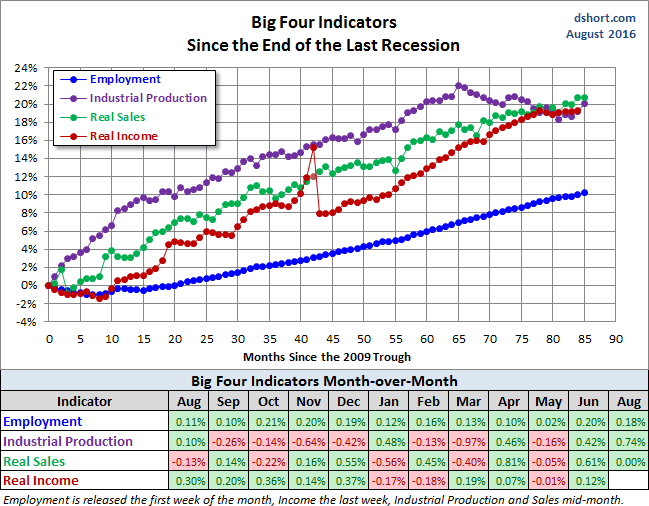We know economies peak and trough. Who decides on those dates?
Many people (even countries) use the convention that 2 or more consecutive quarters of declining real GDP is what makes for a recession. This has the advantage of transparanecy. But its disadvantages are that you’ll probably be waiting 7-9 months for that GDP data. Also, some country’s GDP data is sketchy.
In the U.S., we have an official committee that provides official dates. It’s called the NBER Business Cycle Dating Committee. NBER is short for National Bureau of Economic Research. This is a private group of economists, mostly from top universities. The committee is composed of several top macroeconomists. They typically pin down dates of peaks and troughs a few months after they occur.
Over the decades, they have looked at a huge number of variables. Most of them have the false negative and false positive. Over the last 20 years or so, they’ve settled on four that they think are better than the rest. Do note that these four are coincident indicators: they peak and trough when the whole economy does. The Committee is not doing forecasts, so they’re not looking for leading indicators (and, of course, everyone tries to avoid lagging indicators … like the unemployment rate). Those four variables are:
- Non-farm employment (farms are excluded because they have big seasonal fluctuations)
- Industrial production (most of the economy isn’t industrial, but this is easy to measure and available monthly)
- Real retail sales (the two previous series are real by definition)
- Real personal income excluding transfer payments (because including transfer payments would smooth out personal income).
Here’s how these four look since the last trough:

This graph is copied from the excellent page entitled “The Big Four Economic Indicators: Real Personal Income for November” at advisorperspectives.com. As of the November data (the December data should be out any day now), only industrial production is showing signs of weakness. It’s been doing that for over a year.
Keep in mind that because these are coincident indicators, that if they all started going down this month, we’d probably call that the peak. We’d then expect them all to continue dropping until around the trough.
Here’s what they’re doing right now, if we measure each variable as a percentage off its peak, and then average those figures. (It’s a little tricky, but in the table above, this would be the sum of all the green entries in a column, minus the pink entries in that column, minus all the immediately precedings and uninterrupted pink periods — because no new peak has been set for those series. So that’s 0.18 + 0.34 + 0.25 – 0.90 – 0.16 – 0.02 = –0.31).

All recessions have to start somewhere, so maybe this little downturn we’re in is the start of something. But, for now, we’re not down enough to be too worried. We probably need to get to at least –2.5 to really think recession. For December, you can see that we’re still waiting for one number, whose components come come out on February 1. So far, we’re at –1.34.
Those components are:
- Personal Income = 15,617.6 for November
- Personal Current Transfer Receipts = 2699.7 for November
- Personal Consumption Expenditures: Chain-type Price Index = 109.782 for November.
Subtract the second from the first, multiply by 100, and divide by the third to get the NBER’s preferred number which was 11,766.9 in November. The –1.34 means we’re off the trouble zone by 0.66%, or maybe a bit more. That works out to a drop of 77.7 in this index. So roughly, we should be thinking we’ve peaked with a figure of 11,690, and we probably won’t have any doubts if it’s 30 or 40 points lower than that.
Note that the last table I used is linked to the source. When they updated it on their site, it updated here too.
ReplyDeleteAlso, this uses concurrent indicators as soon as they come out. Those are drafts that get updated each month too.
So, with the December numbers, I ought to redo my November calculations too. This is now 0.18 + 0.34 + 0.20 – 0.90 – 0.16 – 0.02 = –0.36 (which is a little worse than my initial calculation last week). And the calculation for December is 0.20 + 0.00 + 0.29 - 0.36 - 0.90 -0.16 -0.02 = -0.95. That shows the economy continuing to weaken, but it's still not in the range consistent with a peak.
We just looked at this in the 2017 class.
ReplyDeleteThe numbers have been updated, so the calculations in the body of the post only have numbers that are close to what is shown in the table.
Also, the table is dynamic, so it is only showing the last 12 months.
AND ... the source stopped updating that table in August 2016 (probably because our worries about the economy peaking had gone away as the pink cells became rarer).